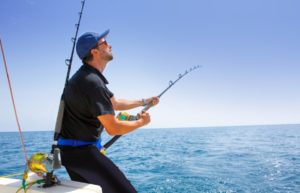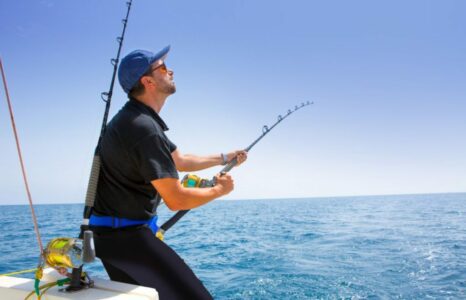 It takes courage to go offshore fishing because you are really off from the shore by several dozens or even hundreds of miles.
It takes courage to go offshore fishing because you are really off from the shore by several dozens or even hundreds of miles.
And since the seabed is deeper by hundreds of meters (sometimes to the depth of a kilometer or two), we are deliberately talking about the deep sea with no shore visible through a naked eye.
With offshore fishing, the first encountered issue is you will always have a set radius to cast the line, and it eventually returns to the boat’s bottom.
The second issue is it is hard to predict the fish’s presence without investing and feeling as the bait gets some teeth on it.
While the boats, tackles, and everything cost a lot in rentals, wasting time in the hope of hooking a few catches can cause dire consequences, especially on your wallet and your mental health.
Unlike the small catches, the giant fishes do not tend to swim too close to the water surface, and they may change their locations in a whizz. They generally swim at a greater depth where you could end up winding down the whole line to its full length.
How to find offshore fishing spots on your own could be a waste of time (sorry to speak), and only technology can best assist you.
Stick with this enormous guide unraveling the best practices gathered from the long experience and do awesome with offshore fishing!
Why Do You Need to Go for Offshore Fishing When You Can End Up Catching Massives from Inshore?
A huge question in length isn’t it, but with a quick answer!
Well, that depends on the situation.
Maybe your whole family wants to go with you on a good-sized boat? Then why not spend the entire day fishing in the deep sea?
The second reason could be that you are fond of catching big! And those big could be a massive big that may be bigger than the size never would have experienced in real life!
So, these two reasons are fair enough to justify offshore fishing.
How to Find Offshore Fishing Spots
Off you go to the deep sea but the question is, does the spot you stopped at containing any sort of fish?
Technology is the best companion for anglers. Gone are the times to use your instincts for the fair share of detecting the presence of fish. Or wait for the fish to take a bite and decide whether it is the right spot to cast or not.
And why you need to take a jibe over technology because finding the ideal fishing spot is a difficult task where you have to reach the fish first.
The case is the complete opposite on inshore fishing spots because the fish (of various sizes) feel safe swimming close to the bay area, and hence you have good chances of successful catches on every casting.
Since there is a considerable depth where you would anchor up, chances are you cannot scan the seafloor to observe what’s down there with your instincts, and of course, with your eyes.
Free Maps to Find the Hot Offshore Fishing Spots
Now, head to where the anglers have found the good catches. Take advantage of the data first, and then the technology.
If you know how to read the Depth Maps, you are likely to land a good amount of catches on your next fishing trip.
Head to USA FisherMap which is completely free and not only portrays the data of inshore but offshore fishing as well.
Look for ‘Fish Haven’, the spots marked on the map for tagging due to the ‘found and caught’ situation, and chances are you can sniff that marked area to test your luck.
As you Zoom Out, the map would differ and would showcase the clear picture of reading the simple data.
And as you Zoom In, you will have the enhanced data in front of you marking the few important readings and Chartplotter view to detect the underwater bodies.
Sad to state but since it misses the exact coordinates for easy navigation, you can use your own Chartplotter device to reach as close to the spot as possible.
Paid Maps to Find the Hot Offshore Fishing Spots
- Find the GPS coordinates of the sizzling fishing locations to go for offshore fishing around North Carolina Cape area!
- Scan the West Coast Florida area neighboring the Gulf of Mexico with accessible GPS coordinates to catch the favorite fish!
- Explore the Clearwater area with this chart bearing the hot fishing maps!
- Go fishing in the Charlotte Harbor area and get your favorite catches like a pro angler!
- Empty out all the Lower Keys Area by reaching straight to the hot fishing spot using the GPS coordinates!
- Fishing Chart and the Nautical Navigation for Offshore Galveston to Rio Grande
- Offshore fishing chart covering MA, RI, CT, NY, and NJ!
- Find various hot fishing spots all the way from Virginia Lower Coast to Upper North Carolina!
Live GPS-Backed Chartplotters a.k.a, the DepthFinders
For those anglers who do not believe in the data and want to test the water on their own because of the extensive experience; we do appreciate this approach!
For them, the GPS-backed chart plotters are the perfect solution to scan the underwater structure. Wherever you both move, you have the live data showing on the chart plotter screen with all the necessary readings in place.
FishFinders
The sophisticated device is the reliable one that detects the live movement of the fish under the water.
Depending on which fish finder you have up for use, the signals tend to hit the seafloor and return back to the device showing where the fish is and its possible size (again, that depends on how equipped the fishfinder is.)
The Commonly-Loved Places for the Ocean Fishes to Hang Around
While the coral reefs, wrecks, and stones attract the most fish species and also provide them with a safe haven; this is the place where the predators (other large fishes) attack and make their tummies fill up.
If you happen to detect what sort of seafloor you got, you are ready to rack in some good amount of gamefish including Tunas, Wahoos, Swordfishes, Tarpons, Marlins, and many more.
Conclusion!
How to find offshore fishing spots becomes incredibly easier only and only with the use of technology.
It not only cuts down on the wasted time but taking you to the prime and ideal fishing spot is super convenient.
Hit the ideal offshore fishing spot, do a few tricks to detect the presence of fish, and be ready to fill up your fish tank with large, precious, and tasty gamefish!
- What Do You Need for Fishing - August 18, 2022
- How to Find Offshore Fishing Spots - August 18, 2022
- What to Use for Trout Fishing - August 17, 2022

